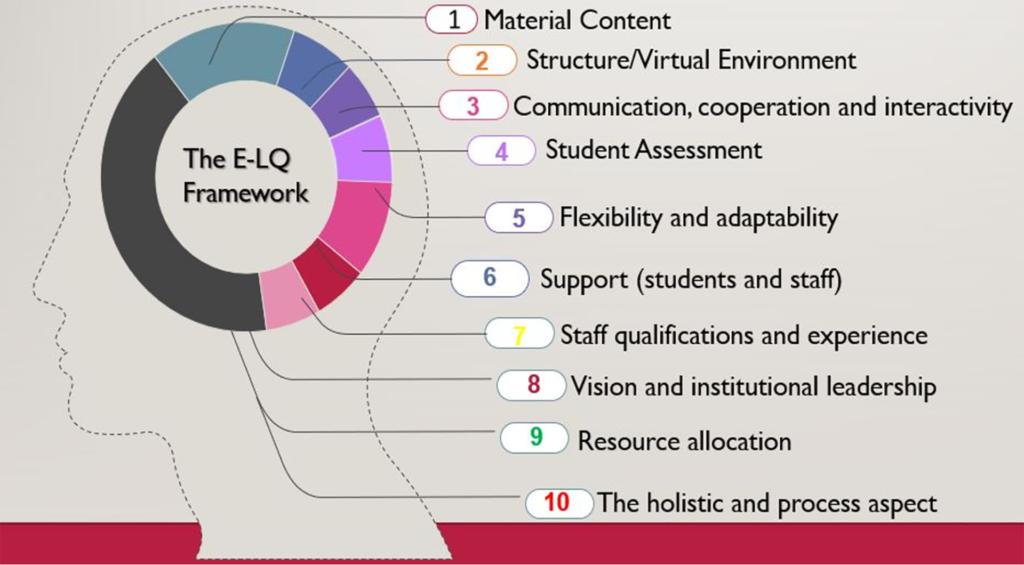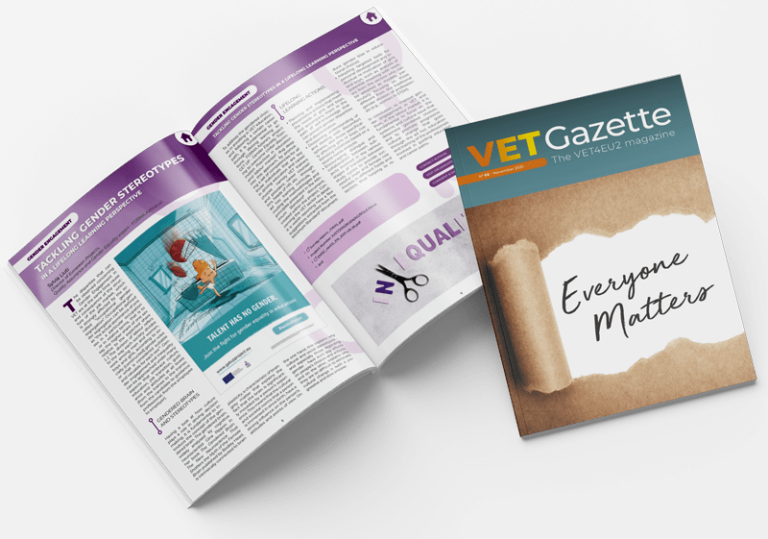The COVID pandemic has profoundly affected Vocational Education and Training (VET) across EU countries, since the delivery of training has been more flexible and the deployment of online and distance learning is now required1. This transformation poses the question: How can quality be achieved on e-learning?
Quality assurance is, indeed, one of the shared challenges of EU member states2, and requires centralized coordination through common policies
EQAVET has been so far the main framework for quality assurance in EU VET systems, while member-states have recorded significant progress on implementing and integrating this framework in their national environments3.
The issue
During the first wave of the pandemic, the delivery of e-learning showed that, while methods and tools for quality assurance have already been developed by HEIs, the VET system lacks such supporting mechanisms. More specifically, the majority of the Higher Education Institutes in Europe have a long-standing experience in distance learning and thus, they have established relevant quality assurance mechanisms. On the contrary, VET education, and especially Technical Vocational Education and Training (T-VET), is still striving to transfer the hands-on experience provided in a laboratory, into an online environment. Also, we cannot omit that the Work-Based-Learning that some VET providers have incorporated in their curricula, should also be delivered online. Finally, this situation deteriorates when it comes to small, local VET providers.
Meanwhile, during the new, digital era, it has been obvious that EQAVET is in need of an update. That is why, on 24 November 2020, the Council of the European Union adopted a Recommendation on VET, which places a strong focus on improved quality assurance. The Recommendation replaces the EQAVET and repeals the former ECVET Recommendation of 20094.
Additionally, on 30 November 2020, the EU Community endorsed the Osnabrück Declaration 2020, promoting resilience and excellence through quality in VET5. Furthermore, by the 30th of September 2020, the European Commission had already adopted two initiatives on the contribution of education and training to Europe’s recovery from the crisis6: The Communication on the European Education Area, and the new Digital Education Action Plan. Both initiatives highlight a common goal: Achieving high-quality in digital education.
The 4 EU Initiatives in a nutshell
The Council Recommendation on VET for sustainable competitiveness,
social fairness and resilience
The Recommendation7 urges EQAVET National Reference Points8 to coordinate the efforts aiming at the self-evaluation of national and regional VET systems, in order to assess their performance as it concerns their digital readiness. At the same time, it suggests the use of European Frameworks (such as DigiComp2 and EntreComp), for a qualitative digitalisation of VET.
The Osnabrück Declaration
This initiative9 highlights the importance of artificial intelligence (including AR/VR technologies), and forecasting tools (such as skills anticipation and graduate tracking), as tools of innovation in VET, especially in remote and rural areas, aiming, at the same time, for social inclusion and equal opportunities to e-learning.
The Communication on the European Education Area
This Communication10 supports the idea that an EU dimension of quality could be achieved via peer-learning and learning mobility. Moreover, it pays special attention to skills that are necessary for a training system to be considered high quality, such as basic skills (i.e. reading), digital skills, and transversal skills (i.e critical thinking).
The Digital Education Action Plan
As it concerns the quality aspect, this Plan11 proposes the creation of a new European Digital Education Hub, to support the cross-sector collaboration upon exchanging digital learning content. Furthermore, the Plan underlines the importance of high-quality digital educational content, and tools and platforms.
The challenge
From the above, we conclude that there is a significant linkage between the digitalization of education and the need for quality improvement. Since most of the national VET providers in decentralized education systems, do not have access to such initiatives, EU-centralized actions could be proved valuable. More specifically, there is a need for an up-to-date, e-learning focused Quality Assurance Framework, on the basis of EQAVET, that could support and complete the national VET systems, as it concerns higher Initial VET providers (IVET).
There is a need for an up-to-date, e-learning focused Quality Assurance Framework
What’s to be done
1. Learning from the HEIs
Since the Higher Education Institutes have long experience in delivering online learning, their developed QA Mechanisms could be modified and transferred to the VET environment. As an example, the E-LQ model is presented.
2. The role of accreditation
According to CEDEFOP, accreditation of both VET organizations per se and their curricula, are correlated with quality, since they are evaluated against predefined standards and criteria before getting accredited15. Thus, these criteria could be integrated into their quality assurance mechanisms.
UNESCO has endorsed the aforementioned linkage between accreditation and quality assurance, also adding that sufficient funding should be earmarked for the accreditation of national VET Institutes16. Actually, there are funding tools such as Erasmus+ (specifically Key-Actions 2 and 3) that could assist the small-scaled VET providers in various EU countries to engineer their Quality Assurance Mechanism.
In this case, again, the role of the EQAVET National Reference Points would be significant, since most times, they are also serving as the main accreditation bodies for their country (e.g. EOPPEP in Greece17).
3. The role of the European Networks
CEDEFOP suggests that national VET providers could be assisted in their QA procedures by, among others, umbrella organizations and endorses the knowledge-transfer and peer-learning that is enabled by such organizations. This is why the “European community of learning providers” was set up in February 2017, with a goal to assist VET providers in being prepared for future challenges18. Thus, national VET providers that wish to update their QA mechanism (or construct a new one), could consult these networks and identify best practices within this EU Community.
From their side, these umbrella organizations could conduct reports with recommendations and guidelines for the development of such mechanisms. In fact, in 2015, they have already published a similar handbook on supporting VET providers with internal quality management and quality culture19. Thus, a similar document should be developed, considering the current challenges. This would result in a knowledge transfer that follows a top-down approach and could benefit all the VET providers and especially the grassroots that are in need of such expertise.
What is the E-LQ?
Swedish National Agency for Higher Education has suggested in 2008 a Model of E-Learning Quality Assessment12. During the preparatory phase, they also consulted a CEDEFOP’s study on “Quality approaches in European e-learning”13 and therefore, the 10 pillars included in this Model, could also pertain to VET education.
Each of the pillars presented above, is followed by respective recommendations/indicators, such as:
1. Guidelines for the selection and development of digital material to be produced
2. The virtual environment should be based on pedagogical needs and aligned to the Institution’s capacity
3. Collaboration and interactivity should be ensured
4. Selection of flexible assessments and focus on plagiarism issues
5. Schedule based on students’ needs and demands
6. Technical, administrative and social support to be provided
7. Increasing staff’s awareness of new technologies
8. Conduction of a long-term strategic plan on e-learning and incorporation of feedback loops
9. New plan on staff’s workload and working hours is needed
10. Internal evaluation, updating, and improvement of all the previous aspectsThe aforementioned pillars could be integrated into EQAVET’s Quality Cycle (Planning-Implementation-Evaluation-Review) and the indicators of the two models could be cross-checked, in order for interoperability to be achieved between the two systems. For example, the EQAVET indicator “Investment in training of teachers and trainers”14 could be completed by the recommendations on the “Staff Qualifications and Expertise” pillar of the E-LQ, since digital competences are now more mandatory than ever.
Finally, EQAVET National Reference Points in each EU country, should also provide consultations upon this procedure and consider adopting and implementing the revised Model.

References
1. Third European Education Summit: Digital Education Transformation – Building Resilience in the European Education Area. (2020, December 22). Education and Training – European Commission. Retrieved February 20,2021
2. Shared challenges in education and training. (n.d.). European Commission – European Commission. Retrieved January 8, 2021
3. EQAVET Secretariat. (2018). Supporting the implementation of the European Quality Assurance Reference Framework – DRAFT Results of EQAVET Secretariat Survey 2018. EQAVET. Also available
4. EU policy in the field of vocational education and training. (n.d.). Education and Training – European Commission. Retrieved February 17, 2021
5. ibid
6. Press corner. (n.d.). European Commission – European Commission. Retrieved January 20, 2021,
7. The Council of the European Union. (2020, December). COUNCIL RECOMMENDATION of 24 November 2020 on vocational education and training (VET) for sustainable competitiveness, social fairness and resilience (2020/C 417/01). Official Journal of the European Union. Also available
8. National Reference Points – Eqavet. (n.d.). EQAVET. Retrieved January 12, 2021,
9. Osnabrück Declaration on vocational education and training as an enabler of recovery and just transitions to digital and green economies. (2020, November). eu2020.de. Also available
10. COMMUNICATION FROM THE COMMISSION TO THE EUROPEAN PARLIAMENT, THE COUNCIL, THE EUROPEAN ECONOMIC AND SOCIAL COMMITTEE AND THE COMMITTEE OF THE REGIONS on achieving the European Education Area by 2025 (625 final). (2020, September). European Commission. Also available
11. Digital Education Action Plan 2021-2027. (2021, September). European Commission. Also available
12. E-learning quality Aspects and criteria for evaluation of e-learning in higher education (Report 2008:11 R). (2008, May). Swedish National Agency for Higher Education.
13. Ehlers et al. (2006, January). Quality in e-learning: use and dissemination of quality approaches in European e-learning: a study by the European Quality Observatory. ResearchGate.
14. Indicator 2 – Eqavet. (n.d.). EQAVET. Retrieved January 20, 2021,
15. Assuring quality in vocational education and training: The role of accrediting VET providers (No. 90). (2011). CEDEFOP. Also available
16. Bateman, A., & Coles, M. (2017). Towards Quality Assurance of Technical and Vocational Education and Training. UNESCO.
17. www.eoppep.gr
18. European community of learning providers. (n.d.). Cedefop. Retrieved February 1, 2021,
19. Publications. (n.d.). Cedefop. Retrieved February 23, 2021,








Responses